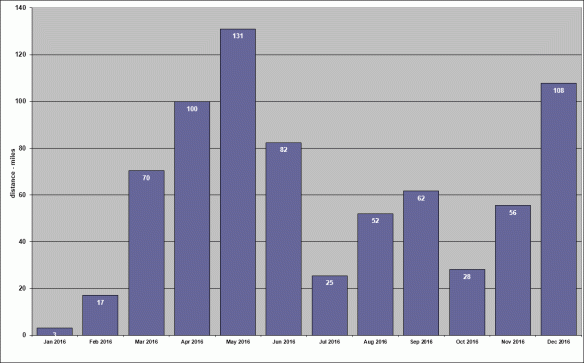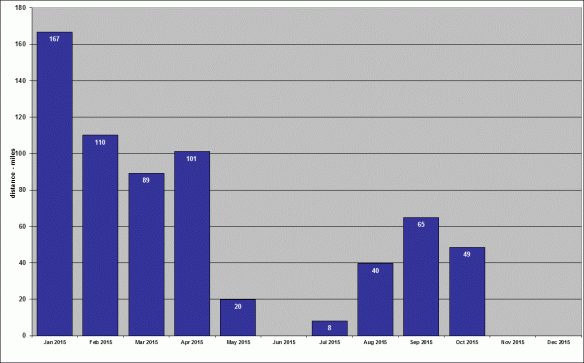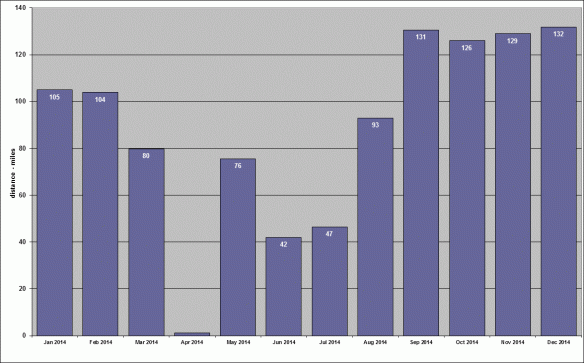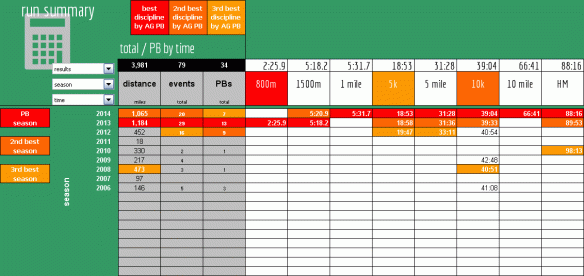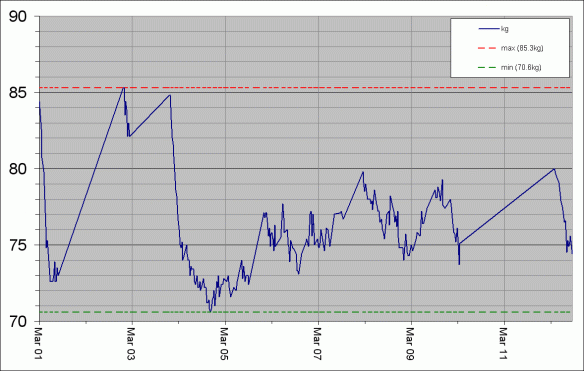At last, after two years in the running semi-wilderness, 2017 was a resoundingly successful year. The dip in mileage during November and December was not due to injury and the lesser dip in April was simply post marathon recovery.

2017 was a resoundingly successful year.
I participated in 20 parkrun 5k events this year, across 5 different venues, and ran most of them competitively. At Dulwich parkrun in August, I improved my longstanding 2014 5k PB of 18:53 to 18:50. In the next two months, I continued to record excellent times – 18:52, 18:54 and 18:52 – every time I ran a parkrun competitively.
Outside parkrunning, I participated in my first marathon, which was a great experience if not an impressive performance, and I improved my 10000m PB twice such that my track time is now on a par with my road PB and the targets I have set for both now seem genuinely realistic. On my 52nd birthday, 1st October, I ran the Kingston Half marathon with the aim of setting a new PB, faster than the now disqualified 86:29 I set at Brighton in 2015. Coming as it did during the best three months of my year – August to October – I was initially somewhat disappointed to run ‘only’ 86:41. But, since Brighton 2015 was officially 146 metres short, it is clear that this is a better performance by any measure. I will definitely be returning next year and hope to be ready to attempt sub 85 minutes.
So, once again my targets for 2018 are unchanged from last year. This year I really want to get on the track and improve my middle distance PBs, but having entered another marathon is not exactly conducive to that! On that note, last year’s Brighton Marathon was hard enough that, at this moment, notwithstanding that I am running strong I think it is unlikely I will commit to my sub 3:10 target time from the gun.
| 2017 season | 2018 season | |||||
|---|---|---|---|---|---|---|
| event | opening PB | target | events | improvement | target | |
| 800m | 2:25.9 | 2:19.9 | — | — | 2:19.9 | |
| 1500m | 5:18.2 | 4:49.9 | — | — | 4:49.9 | |
| mile | 5:31.7 | 4:59.9 | — | — | 4:59.9 | |
| 3000m | — | 9:59.9 | — | — | 9:59.9 | |
| 5000m | 19:01.53 | 17:59.99 | — | — | 17:59.99 | |
| 5k | 18:53 | 17:59 | 20 | August 18:50 | 17:59 | |
| 5 mile | 31:28 | 29:59 | — | — | 29:59 | |
| 10000m | 40:41 | 38:29.99 | 2 | June 40:28.20, September 39:05.53 | 38:29.99 | |
| 10k | 39:04 | 38:29 | 1 | — | 38:29 | |
| 10 mile | 66:41 | 64:59 | — | — | 64:59 | |
| half marathon | 84:59 | 1 | October 86:41 | 84:59 | ||
| marathon | — | 3:09:59 | 1 | April 3:47:58 | 3:09:59 | |
I am still in denial about getting older and so I am holding out for absolute PBs – that is improvements in my best times. However, for the sake of completeness shall we say, I have listed my age grade (AG) bests and am particularly hopeful that 2018 will see the achievement of my longstanding goal of an 80% age grade.
| event | time PB | AGe when set | AG of time PB when set | AG PB | age when AG PB set | |
|---|---|---|---|---|---|---|
| 800m | 2:25.9 | 48 | 78.32% | same | — | |
| 1500m | 5:18.2 | 48 | 72.77% | same | — | |
| mile | 5:31.7 | 48 | 75.50% | same | — | |
| 3000m | — | — | — | — | — | |
| 5000m | 19:01.53 | 49 | 72.21% | same | — | |
| 5k | 18:50 | 51 | 78.94% | 79.42% (18:52) | 52 | |
| 5 mile | 31:28 | 49 | 76.91% | same | — | |
| 10000m | 39:05.53 | 51 | 77.64% | same | — | |
| 10k | 39:04 | 49 | 77.94% | 78.20% (39:54) | 52 | |
| 10 mile | 66:41 | 48 | 74.33% | same | — | |
| half marathon | 86:41 | 52 | 78.58% | same | — | |
| marathon | 3:47:58 | 51 | 61.73% | same | — |

